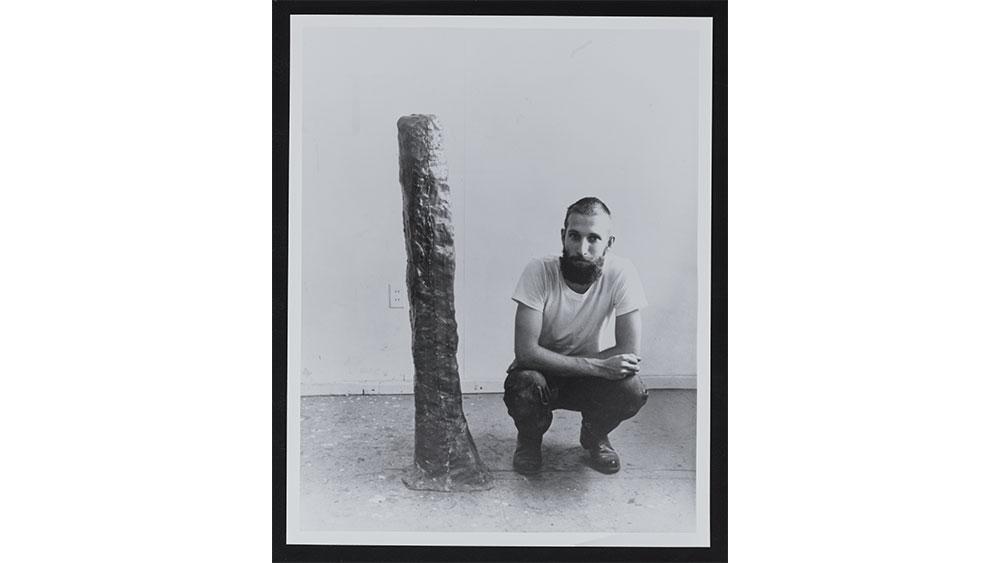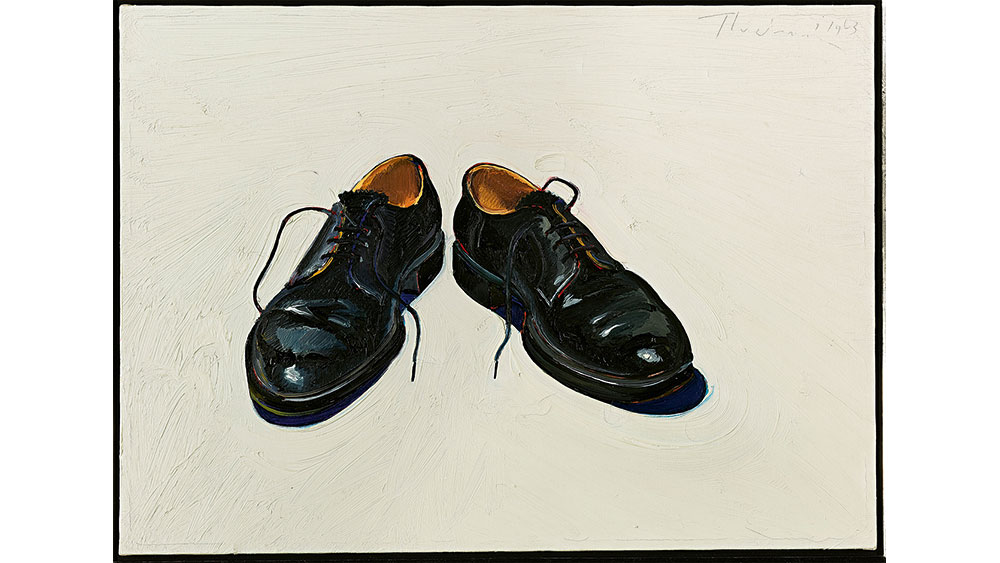In the fall of 1964, Bruce Nauman, the internationally recognized conceptual artist, matriculated at UC Davis. During his first quarter in graduate school he served as a teaching assistant for Wayne Thiebaud’s life drawing class, where he learned foundational attitudes about art-making that would be an ongoing influence throughout his career. Later Nauman fondly recalled the atmosphere at Davis: “They’d say, ‘Well, you can do that’ … and they wouldn’t say it was good or bad, or you could have made it better if you had done that. … Not that it wasn’t critical. If there was a work that they didn’t like, they’d say it was a pile of shit. But there was just sort of an open feeling, and it was hard for a lot of people being left alone that much, but it worked out really well for me. It was just what I needed.”[1]

Bruce Nauman next to his first cast fiberglass piece, ca. 1965 unknown photographer Leo Castelli Gallery
At Davis, Nauman began to work with film and video. “Films are about seeing. I wanted to find out what I could look at in a strange situation.”[2] In 1966, he collaborated with William Allan, a friend of William T. Wiley who was in turn especially close to Nauman. Together they created a series of short films made in the spirit of what the artists called “shop films,” or instructional guides on how to do, or make, any number of household tasks.

Wayne Thiebaud, Shoes (Black Shoes), 1963, oil on canvas.
Abstracting the Shoe was their first film. The set-up, common to all their work together, was a deadpan take on an absurd task. True to the film’s title, the two artists apply roofing tar to a wooden prop that is shaped like a shoe and sits next to a black wingtip. They continued to apply these straightforward mechanics to their metaphorical interests in subsequent films: Fishing for Asian Carp (the artists attempt to catch fish with their hands); Legal Size (Nauman carefully extends the length of a standard envelope with tape); and Span (the artists frame a plastic tarp set in a meadow).
According to the artists, their selection of subject was incidental, haphazard even. “The films I did with Bill Allan are the closest to just making a film, without considering art,” Nauman has explained.[3] Their choice to work with shoes may have been influenced by coincidence — in Davis Nauman lived over a shoe-repair store — but the idea to abstract the shoe is no doubt an allegory of the art-making process. And the wingtip is not difficult to imagine as a reference to Thiebaud (who stood out among the faculty for his natty dress), and his still life paintings of black dress shoes. In the film, the artists abstract Thiebaud’s realism, transform his painterly subject into a film that produces a sculptural object; one way to see the video is that of a student wrestling with the legacy of his mentor’s influence. By this point in his graduate education Nauman had abandoned painting. In 1966, as he was making this film, he was actively pursuing new forms and new methodologies with which he would make his mark on the art world.
At the same time, Allan and Nauman’s how-to film, with its allusions to Thiebaud, is a paean to Thiebaud’s subject and exquisite technique. The film records Nauman applying a paint like substance in a thick impasto; it almost looks like black icing. Much later in life Nauman reflected on two of his most influential teachers — master horse trainer Ray Hunt and Thiebaud. Thiebaud, he says taught him “how to pay attention.” “Pay attention” is more than a directive for Nauman. “Pay attention” is a thesis that underwrites the entirety of his extraordinary body of work.
Nauman returned to the how-to construct, in a digital video from 1999, Setting a Good Corner (Allegory and Metaphor) . The video reprises many of the same key themes: process, art-making, labor and duration. Over the course of an hour we see Nauman digging a post hole and setting a post in a fence on his New Mexico ranch. At the end, the video image fades to text with Nauman’s ranch partner, Bill Riggins, providing commentary on the quality of Nauman’s work. Here Nauman more openly acknowledges the allegorical and metaphorical meaning of what reads as a slice-of-life home video. Learning good process, putting in hard labor, tending your tools, and the rigor of assessing your own work are all fundamental to a meaningful art practice, just as they are key to building a fence that will withstand the desert climate. Nauman learned to appreciate these fundamentals from Thiebaud, a teacher whose influence he continues to recognize today.
[1] Lorraine Sciarra, “Bruce Nauman, January, 1972,” in Janet Kraynak, ed., Please Pay Attention Please: Bruce Nauman’s Words: Writings and Interviews (Cambridge, Mass.” MIT Press, 2003) p. 157.
[2] Joe Raffaele and Elizabeth Baker, “The Way-Out West: Interviews with Four San Francisco Artists,” (Fall, 1966) in in Janet Kraynak, ed., Please Pay Attention Please: Bruce Nauman’s Words: Writings and Interviews (Cambridge, Mass.” MIT Press, 2003) p. 105.
[3] Ibid.

